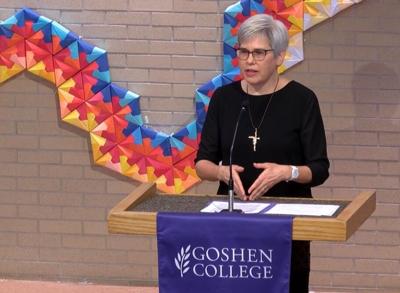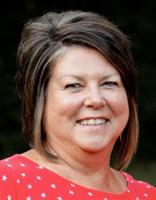GOSHEN — It was a day for sharing perspectives, reflection and a renewed commitment to the ongoing work of equity and justice at Goshen College on Monday morning as students, faculty, staff and community members were called to participate virtually in the annual Martin Luther King Jr. Study Day.
During the annual celebration, students at the college pause their usual activities to take part in an inspiration-filled presentation — this year presented virtually due to COVID-19 — celebrating King’s message of equality for all individuals, no matter their race, gender or place of origin.
That message, brought so vividly to life on Aug. 28, 1963, with his famous “I Have a Dream” speech on the steps of the Lincoln Memorial, served as a catalyst in the American Civil Rights Movement, the message of which continues to inspire to this day.
Helping to kick off Monday’s celebration was GC President Rebecca Stoltzfus, who spoke on the day’s theme of “Equity & Justice in Action at Goshen College.”
“It’s a privilege to speak to honor the Rev. Dr. Martin Luther King Jr., and to draw connections from his life and legacy to us, and where we are today, and where we go from here,” Stoltzfus said in beginning her talk Monday.
SOBERING STATISTICS
To help set the stage for her discussion, Stoltzfus first laid out some statistics related to what King described as “Black disappointment,” where the movement toward racial justice in the United States has historically had a rhythm of advance followed by backlash and regression.
“Dr. King wrote in 1967, ‘Black people have half the income of whites, there are twice as many unemployed, the rate of infant mortality — widely accepted as an accurate index of human health — is double that of whites. Segregated Black schools receive substantially less money than do the white schools. One-twentieth as many Blacks as whites attend college,’” Stoltzfus said. “So, where are we now? In earnings, in 2019, Black-headed households had 60% the income of white-headed households. In the fourth quarter of 2020, Black adults were 1.7 times more likely to be unemployed than white adults.
“In education, the gap in school funding still exists,” she added. “In 2019, even when controlling for the income of those school districts, school districts with high concentrations of non-white students received $1,500 less per student from their governments than those with concentrations of white students, a finding that hammers home the deep roots of racial inequality in education funding.”
Speaking to college specifically, Stoltzfus noted that while significant progress in college attainment has been made since 1967, a striking gap still remains.
“In 2019, white adults were 1.5 times more likely to have obtained a bachelor’s degree than Black adults,” Stoltzfus said. “And in health, the latest U.S. national data show that Black babies are more than twice as likely to die in the first year of life than white babies. Even worse, Black women are more than three times more likely to die pregnancy-related deaths than white women. And since the pandemic began, Black people are 1.6 times more likely to have died from COVID.
“It is shocking how little progress has been made in closing gaps in these very indicators that Dr. King called out in 1967,” she added. “The root causes of these persistent inequalities are complex, but they are assuredly not inherent to the bodies and the minds of Black people. These are the outcomes of systemic racism. Because of these immoral and persistent inequalities, Goshen College joins in saying Black lives matter; not more than other lives, but in the face of such injustice, Black lives must draw our concerted attention.”
EMOTIONAL IMPACTS
Moving beyond the statistics, Stoltzfus then turned her focus inward to probe what she called the more internal motivators of where we find ourselves today: our pain, our fear and our anger.
“As we gather in January 2021, we continue to process the many layers of suffering and violence that we have witnessed in the last year: the coronavirus pandemic, the deaths of Black people at the hands of police, mean-spirited and divisive politics, and an armed siege of the United States Capital. Racism has shaped each of these traumas, and the ways that they land unequally on us,” Stoltzfus said. “We are immersed these days in rhetoric that is designed to frighten us, and it is working. Fear is a powerful motivator. Frightening headlines and sound bites strike us when we are vulnerable to the virus, our trust is low, and our interdependence on one another is scary to us. Throw in racially inflammatory messages and symbols, and our collective fear is palpable.”
Referencing a stark example of that fear’s impact and how many in the nation have responded to it, Stoltzfus noted that gun sales jumped by more than 90% in the days following the arrival of COVID-19 back in March of 2020.
Gun sales would surge again in June following the murder of George Floyd by police, she said, and would hit an all-time high the week of June 19, also known as Juneteenth, or the anniversary of the day when slaves were declared free under the terms of the Emancipation Proclamation.
“Gun sales in 2020 tracked our collective racial animus, which social science researchers measured by the number of daily Google searches of racial epithets,” Stoltzfus said. “Racial animus has surged this year, and so have gun sales. In total, 3 million more guns were legally purchased in 2020 than expected from previous years. In terms of race, white Americans are more likely to own a gun than Black Americans. Black Americans are twice as likely to die from gun violence overall, and are killed by police at twice the rate of white people.”
ANGER IS USEFUL
Segueing away from the topic of fear, Stoltzfus then transitioned to the topic of anger, and, more specifically, how the harnessing of anger is not necessarily a bad thing when it comes to the ongoing fight for equity and justice.
“Our present fear is accompanied by a lot of anger,” Stoltzfus said. “Now, that is not bad. If you don’t feel some anger after hearing these statistics, perhaps you’re a little sleepy this morning. Anger is not bad. Anger can be a force for good. Anger is useful, because like pain, it signals that something needs attention, either within us, or around us. Something needs to change.
“Anger is an essential, energetic force in our movements toward justice; that is, if we learn the disciplines needed to harness that energy for good,” she added. “And this was part of the effectiveness of Dr. King’s leadership. ... Nonviolent direct action has proved to be the most effective generator of change that the movement for racial justice has seen.”
That legacy lives on today, she said. As an example, she pointed to the racial justice uprisings that followed the murder of George Floyd early last year. While some have attempted to paint these uprisings as inherently violent, she noted that in large part, this simply is not the case.
“Ibram Kendi, American professor, anti-racist activist and historian of race, documented that in the summer of 2020, there were more than 8,000 demonstrations for social justice in every state of this nation, and 93% of them were peaceful, including those in the city of Goshen, and lining the streets of this campus,” Stoltzfus said. “Mariame Kaba, one of the many leaders within those protests, has noted that in 2020, people in the movement knew what to do — not only how to act, but how to support and care for one another in the streets and when arrested.
“The legacy of nonviolent action is one that we must tend, and sustain,” she added. “Now, let me be clear, my affirmation of nonviolence is not meant to control Black anger, or protect white people from Black violence. Undisciplined white anger, white supremacy and white violence is a far greater threat. My point is in answer to King’s question, ‘Where do we go from here?’ From this place of fear, and pain, and anger ... We must work toward community. And to do that, we must learn nonviolent ways of being together, and of resolving our differences.”
DISRUPTORS OF RACISM
And, speaking as a white person, Stoltzfus noted that in order to have a chance at building that community, it means those who are white must take responsibility to learn, to change and to act on behalf of racial equity and justice.
“We white people need to learn to see our own privilege and racism more clearly, to motivate each other to continually develop healthy and effective anti-racism practices, and to support one another, and keep us moving forward when we fail,” Stoltzfus said in concluding her speech Monday. “For the first time in my personal experience — not to say that this hasn’t happened for others — but for my personal experience, I am part of, and I see white people coming together in new ways to attend to issues of race grounded in a positive sense of our racial selves, a commitment to our own healing, individually and collectively. We can develop a culture that challenges the dominating whiteness that has been the crippling wound in our nation, and also on our campus, for too long.
“I feel unbearable longing for the collective liberation from racial injustice that we need. It is corroding us: our health, our economic security, our safety, our democracy,” she added. “We have work to do together, and that work gives me hope. Fueled by a spirit of prophetic love, let us, like Dr. King, fully and creatively engage the living history of this moment. Let us be those creative disruptors of racism who call our beloved nation, and our beloved Goshen College, to an ever more noble and true expression of equity and justice in action.”










